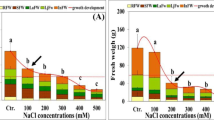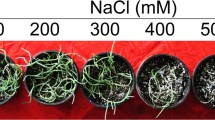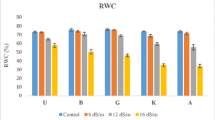Abstract
A pot culture experiment was performed to evaluate salt tolerance potential ofSesbania aculeata Poir. The plant can tolerate salinity levels up to electrical conductivity (ECe), 10 mS cm−1 and at 15 mS cm−1 thero is about 40% reduction in dry matter production. The analysis of inorganic constituents in different plant parts revealed that the plant has the capacity to regulate sodium uptake under saline conditions and chloride uptake always exceeded that of sodium. The potassium: sodium ratio is also maintained at a fairly constant level in leaflets while it is reduced in leaf rachis, stem and roots. Salt stress caused accumulation of calcium and magnesium in all plant parts. A considerable decline in phosphorus uptake was observed due to salinity. Iron was found to be accumulated more in salt stressed roots only. Nitrogen accumulated in both roots and leaves while considerable proline accumulation was observed in leaves of salt stressed plants. The amount of soluble sugars was increased in roots and leaves due to salt stress, while starch content of roots decreased. Those changes induced by salinity are discussed in relation to salt tolerance capacity of the plant.
Similar content being viewed by others
References
Albert, R..Falter, J.: Metabolism of lime-free leaves ofTilia cordata injured by deicing salts. 2. Nitrogen and carbohydrate metabolism. - Phyton19: 141–162, 1979.
Ayoub, A. T.: Some primary features of salt tolerance in Senna (Cassia acutifolia). - J. exp. Bot.28: 484–492, 1977.
Bernstein, L.: Salt tolerance of field crops.-US Salinity Lab. Rep. Collaborators (Riverside, Calif.): 33–34, 1956.
Bernstein, L.: Effect of salinity and sodicity on plant growth. - Annu. Rev. Phytopathol.13: 295–312, 1975.
Bharadwaj, K. K. R.: Note on the distribution and effectiveness of Rhizobium ofSesbania aculeata Poir in saline alkali soils.- Indian J. agr. Sci.44: 683–684, 1974.
Chavan, P. D., Karadge, B. A.: Influence of salinity on mineral nutrition of peanut (Arachis hypogaea L.). -Plant Soil:54: 5–13, 1980.
Dahiya, S. S., Singh, M.: Effect of salinity, alkalinity and iron application on availability of iron, manganese, phosphorus and sodium in pea (Pisum sativum) crop. - Plant Soil44: 697 to 702, 1976.
Epstein, E.: Mineral Nutrition of Plants: Principles and Perspectives. - John Willey and Sons Inc., New York 1972.
Epstein, E., Norlyn, J. D., Rush, D. W., Kingsbury, R. W., Kelley, D. B., Cunningham, G. V., Wrona, A. F.: Saline culture of crops: A genetic approach. - Science210: 399–404, 1980.
Flowers, T. J., Troke, P. F., Yeo, A. R.: The mechanism of salt tolerance in halophytes. -Annu. Rev. Plant Physiol.28: 89–121, 1977.
Gates, C. T., Haydock, K. P., Robins, M. F.: Response to salinity inGlycine,4. Salt concentration and the content of phosphorus, potassium, sodium and chloride in cultivars ofGlycine wightii (G. javanica). - Aust. J. exp. Agr. anim. Husb.10: 99–110, 1970.
Guillen, M. G., Caro, M., Fernandez, F. G., Cerda, A.: Foliar composition of citrus seedlings irrigated with saline waters. - Commun. Sci. Plant Anal.9: 595–606, 1978.
Hawk, P. B., Oser, B. L., Summerson, W. H.: Practical Physiological Chemistry. - The Blakiston Company, U.S.A. 1948.
Karadge, B. A., Chavan, P. D.: Salt tolerance studies in groundnut (Arachis hypogaea L.) variety TMV-10. -Biovigyanam7: 137–144, 1981.
Kleinkopf, G. E., Wallace, A., Cha, J. W.: Sodium relations in desert plants. Some physiological responses ofAtriplex confertifolia to different levels of sodium chloride. - Soil Sci.120: 45–48, 1975.
Larsen, H.: Biochemical aspects of extreme halophilism. - Adv. Microbiol. Physiol.1: 97 to 132, 1967.
Laszlo, E., Kuiper, P. J. C.: The effect of salinity on growth, cation content, Na+ uptake and translocation in salt sensitive and salt tolerantPlantago species. - Physiol. Plant.47: 95–99, 1979.
Iessant, H., Marschner, H.: Relation between salt tolerance and long distance transport of sodium and chloride in various crop species. - Aust. J. Plant Physiol.5: 27–31, 1978.
Maas, E. V., Ogata, G., Garber, M. J.: Influence of salinity on Fe, Mn and Zn uptake by plants. -Agron. J.64: 793–795, 1972.
Matar, Y., Doering, H. W., Marschner, H.: Effect of NaCl and Na2SO4 on dry matter production, mineral content and organic compounds of spinach ami lettuce. - Z. Pflanzenernähr. Bodenk.3: 295–307, 1975
Rozema, J.: An ecophysiological study on the response to salt of four halophytic and glycophyticJuncus species. - Flora165: 197–209. 1976.
Rush, D. W., Epstein, E.: Genotypic response to salinity, difference between salt sensitive and salt tolerant genotypes of the tomato. - Plant Physiol.57: 162–166, 1976.
Steiner, M.: Zur Oekologie der Salzmasschen der r nordöstlichen vereinigten Staaten von Nordamerika. - Jahrb. wiss. Bot.81: 94–202. 1975.
Weimberg, R., Levner, H. R., Poljakoff-Maybfr, A.: A relationship between potassium and proline accumulation in salt stressedSorghum bicolor. - Physiol. Plant.55: 5–10, 1982.
Wilson, J. R., Haydock, K. P., Robins, M. F.: Response to salinity inGlycine. V. Changes in the chemical composition of three Australian species andG. uightii (G. javanica) over a range of salinity stresses. - Aust. J. exp. Agr. anim. Hasb.10: 156–165, 1970.
Author information
Authors and Affiliations
Rights and permissions
About this article
Cite this article
Karadge, B.A., Chavan, P.D. Physiological studies in salinity tolerance ofSesbania aculeata POIR. Biol Plant 25, 412–418 (1983). https://doi.org/10.1007/BF02903138
Received:
Accepted:
Issue Date:
DOI: https://doi.org/10.1007/BF02903138




